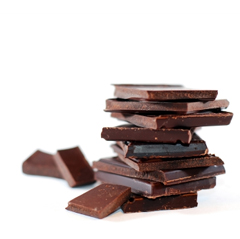Medicinal Chocolate . . . Part 2
February 28, 2008
I’m still waiting to hear back from Silas Deane about the studies funded by his group—the National Foundation for Cancer Research—on the cancer-fighting benefits attributable to chocolate antioxidants. However, when Deane and I spoke on Tuesday, I did question him about whether the compounds that proved beneficial in his group’s study were the same flavonoids that have proven useful in reducing risks associated with heart disease. He said they were.

He also emailed me a 2-year-old paper that one of NFCR’s grantees had coauthored. It showed that the flavonoids in dark chocolate have beneficial effects in relaxing the blood vessels in people who downed the beverage and in blood vessels looked at during studies of isolated tissues.
That research had been funded using cocoa provided by Mars Inc., the candy company that makes M&Ms and Dove bars.
One of the authors of that study forwarded by NFCR was Harold H. Schmitz. He has the enviable job of being the chief scientist at Mars. (Yum)
At an industry-sponsored cocoa symposium, a month after Schmitz’s 2006 paper came out, University of California scientists presented some provocative data that Schmitz says countered a longstanding myth: that a person can get cocoa’s heart-protecting constituents simply by downing any off-the-shelf dark chocolate.
For instance, standard commercially processed cocoa powder had a high concentration of antioxidants—just not the flavanols that were responsible for effects in the 2006 study. Not surprisingly, the standard commercial cocoa provided almost no cardiovascular benefits in short-term tests with people who drank dark-chocolate cocoa or in tests using isolated tissues. For more on those findings, check out Prescription Strength Chocolate, Revisited.
Many published studies demonstrating health benefits attributable to chocolate have been funded by Mars using dark-chocolate cocoa or dark chocolate that the company supplied to outside scientists. Indeed, for many years, Mars has been investing big bucks to probe the potential health benefits of chocolate—investments that the company hopes will pay off in new product lines that could shed the candy’s junk-food reputation. These studies have shown that most of chocolate’s heart benefits—and they can be substantial—trace to flavanols, a class of antioxidant flavonoids.
The proprietary recipe for many of the Mars products used in these studies retains nearly all of the natural-cocoa flavanols that chocolate processing ordinarily cooks and washes out, according to studies that Schmitz and others have published. Interestingly, University of California researchers presented data at the 2006 conference indirectly suggesting that at least some of the flavanols’ benefits trace to functions other than fighting oxidation.
Unfortunately for you and me, the high-flavanol cocoa that performed well in Mars-funded studies isn’t commercially available. If enough people pester the company for the cocoa, Schmitz says, “eventually we might have to offer such a product.” In the meantime, his company does sell a somewhat pricey candy, CocoaVia, in relatively low-calorie, flavanol-rich portions.
What about other companies’ dark chocolates and cocoas? Short of paying for costly chemical analyses, Schmitz says, there’s no way a consumer can find out whether such products retain much of the flavanols that had been in the starting cocoa beans.
So what’s a consumer to do if we can’t be sure our dark chocolate has the flavanols that are ostensibly health promoting? Eat chocolate because it tastes good.
But in moderation. Good-tasting chocolate tends to be high in fat, which means high in calories. And getting fat will certainly aggravate any other risk of chronic disease, including cancer, diabetes, and cardiovascular disorders.






